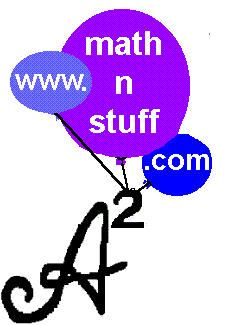![[Top]](http://www.mathnstuff.com/gif/top.gif) 2.Other Tongue(s)
2.Other Tongue(s)
|
© '98, Agnes Azzolino |
Mother Tongue |
Other Tongue(s) |
Formal Spoken Mathematics |
Informal Spoken Mathematics |
Spoken Symbol |
Symbol Speak |
Calculatoreze/Computereze |
Web Speak |
![[Top]](/www.mathnstuff.com/gif/top.gif) 1. The Mother Tongue
1. The Mother Tongue
Language, as embodied in a mother tongue, was spoken long before mathematics was created.
This makes the mother tongue the most basic of math class languages even though the verbal languages are in general the most sophisticated.
If the listener doesn't understand the mathematics, speak the mathematics in the mother tongue or in a more concrete language.
![[Top]](http://www.mathnstuff.com/gif/top.gif) 2.Other Tongue(s)
2.Other Tongue(s)No specific mathematics examples are necessary for this language. It is listed because other tongues are spoken in math classes and a list would not be complete without acknowledgement of this fact.
 |
3. Formal Spoken Mathematics |
Say "mathematics" not "math." |
4. Informal Spoken Mathematics |
Say "math" not "mathematics." |
Formal spoken mathematics is the only language spoken by many - usually the teacher or professor. Informal spoken mathematics is spoken by many - usually the student or novice.
Communication may not occur - the student may not understand the teacher, or the teacher may not understand the student - if some bilinguality does not exist.
![[Top]](http://www.mathnstuff.com/gif/top.gif)
| "one more than twice an number" | VS | "two 'eks' plus one" |
| "The square of the sum of two numbers equals the sum of the square of the first, the square of the second, and twice the product of the two numbers." | VS | "a plus b the quantity squared equals a squared plus two a, b, plus b squared" |
| "three 'eks' minus five is twenty" | VS | "Five less than the product of three and a number equals twenty." |


 7. Calculatoreze/computereze
7. Calculatoreze/computerezeThis language is used to say a correct or corrupted calculator key which is not algebraic vocabulary.
 8. Web Speak
8. Web SpeakReferences
[Verbal] [Written]
[Pictorial] [Concrete]


Verbal, Written, Pictorial, and Concrete (the Hundreds Board, for example) are the four broad mathematics language families discussed in this electronic monograph found at www.mathnstuff.com/papers/langu/page0.htm and additional pages (ISBN: 1-929-870-01-9 © 1998, Agnes Azzolino).
![[MC,i. Home]](http://www.mathnstuff.com/math/spoken/here/1gif/mcihome.gif)
![[Table]](http://www.mathnstuff.com/math/spoken/here/1gif/table.gif)
![[Words]](http://www.mathnstuff.com/math/spoken/here/1gif/words.gif)

![[this semester's schedule w/links]](http://www.mathnstuff.com/gif/semestr.gif)
![[Good Stuff -- free & valuable resources]](http://www.mathnstuff.com/gif/goods.gif)
![[next]](http://www.mathnstuff.com/math/spoken/here/1gif/next.gif)
![[last]](http://www.mathnstuff.com/math/spoken/here/1gif/last.gif)
© 2005, Agnes Azzolino www.mathnstuff.com/math/spoken/here/papers/langu/page5.htm |